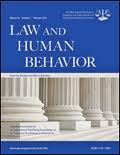 Developmental factors serve to tip adolescents’ risk appraisals toward risk-taking, which contributes to adolescent offending. This is the bottom line of a recently published article in Law and Human Behavior. Below is a summary of the research and findings as well as a translation of this research into practice.
Developmental factors serve to tip adolescents’ risk appraisals toward risk-taking, which contributes to adolescent offending. This is the bottom line of a recently published article in Law and Human Behavior. Below is a summary of the research and findings as well as a translation of this research into practice.
Featured Article | Law and Human Behavior | 2013, Vol. 37, No. 6, 412-423
Reward-Biased Risk Appraisal and Its Relation to Juvenile Versus Adult Crime
Author
Abstract
To what extent is criminal behavior in adolescence attributable to risk appraisal? Using two large cross-sectional samples (N = 929, age range: 10 –30 years; and N = 1,357, age range: 12–24 years), we examine whether (a) reward bias in risk appraisal is more prominent in adolescence and (b) the association between risk appraisal and criminal behavior is stronger during adolescence than at other ages. In Study 1, criminal behavior was self-reported; in Study 2, it was defined by involvement with the court. Perceived chances of a negative outcome, seriousness of consequences, and benefits versus costs of various risky activities were assessed to gauge reward bias in risk appraisal. The findings indicate that reward bias is elevated during the adolescence years. Also, risk appraisal bears a stronger relation to self-reported crime in middle adolescence and to official law-breaking behavior in early adolescence than at other ages. The findings are consistent with a dual-systems model of adolescent development and align with recent U.S. Supreme Court decisions addressing juvenile offenders’ culpability.
Keywords
risk perception, crime, risk-taking, adolescence, reward-bias
Summary of the Research
This research used two large datasets to test hypotheses regarding the relations between adolescent development (risk perception) and juvenile crime. The researchers “theorized that criminal behavior in adolescence results, in part, from reward bias in adolescent risk appraisal, reduced capacity to temper initial responses, and weaker ability to restrain approach impulses (resulting from risk appraisal) in the face of potential rewards. To the extent that this developmental model is correct, we would expect that reward bias in risk appraisal—the tendency to perceive greater rewards, fewer costs, and less danger associated with risky activities—would be generally more pronounced in middle adolescence than in earlier or later stages of development. In addition, if adolescents are less likely to modulate or reappraise their initial risk judgments and are less able to restrain their impulses, then we would expect the relation between risk appraisal and law-breaking behavior to be stronger among adolescents than among adults” (p. 414).
Study 1: To examine whether adolescents have elevated levels of reward bias and whether reward bias is more strongly associated with law-breaking among adolescents than adults, data from 929 participants, aged 10-30 years, recruited from 5 geographic locations (Denver, CO; Irvine, CA; Los Angeles, CA; Philadelphia, PA; Washington, DC) were analyzed. Participants in this study had completed measures of law-breaking, risk perception, age, and several control variables. Results indicated that adolescents had elevated levels of reward bias compared to adults (reward bias increased steadily until age 16-17, at which point it peaked and began to decline into adulthood). In addition, results indicated that reward bias is more strongly associated with (self-reported) law-breaking behavior among adolescents than adults. “Age, IQ, and sex were also linearly associated with law-breaking behavior such that older individuals, higher IQ individuals, and females reported less law-breaking behavior than did younger individuals, lower IQ individuals, and males” (p. 416). One shortcoming of this study is that the data for both risk perception and law-breaking behavior were self-reported. The next study addressed this limitation.
Study 2: To examine whether the results of Study 1 were replicable, data from 1,357 participants, aged 11-24 years, drawn from 4 geographic regions (Los Angeles, CA; Philadelphia, PA; Virginia; Florida) were analyzed. Half of the participants were court-involved individuals, recruited from juvenile detention facilities and adult jails, whereas the other half of the participants were drawn from the community and had no court involvement. Court involvement was used as an index of law-breaking behavior (as a means of addressing the limitation of using self-reports of law-breaking behavior in Study 1). Results indicated that community (non-court involved) adolescents showed elevated levels of reward bias compared to adults (reward bias increased steadily until age 14-15, at which point it peaked and began to decline into adulthood). In addition, results indicated that reward bias is more strongly associated with law-breaking behavior (court involvement) among adolescents than adults.
“The findings [from both of these studies] support the hypothesis that reward bias is more strongly associated with law-breaking behavior among adolescents than adults…Overall, the results support the hypotheses that adolescent risk appraisal (compared to that of adults) is biased toward reward (over cost) and translates more directly into criminal risk-taking” (p. 419).
Translating Research into Practice
“The results of the two studies included in the present analysis support two conclusions. First, adolescents are more reward-biased in their risk appraisals than adults or preadolescents. Second, even accounting for this age effect, reward bias correlated more strongly with both self-reported law-breaking behavior (in a large community sample) and with officially alleged law-breaking behavior (in a large sample of detained/incarcerated individuals and a community comparison sample) during early-to-middle adolescence than during adulthood. These patterns are robust to adjustments for sex, intelligence, and social class. In all, the findings are consistent with the dual-systems model of adolescent development, and they support the view that adolescent offending is partly attributable to developmental factors that tip adolescents’ risk appraisal toward risk-taking” (p. 420).
The authors of this article included an important section on the study implications for legal policy. They note that this research serves to reinforce the notion that adolescent crime is, in part, a product of developmental immaturity and argue, “in light of the developmental evidence, adolescence itself should be viewed as a mitigating circumstance and adolescent defendants should be considered categorically distinct from adult defendants” (p. 421). Thus, developmental considerations might serve to mitigate blameworthiness or culpability.
The authors note that the U.S. Supreme Court has shown signs of agreeing with this position as it has considered the issue of whether immaturity mitigates culpability three times in the past decade (Roper v. Simmons, 2005; Graham v. Florida, 2010; Miller v. Alabama, 2012).
Another implication of this research is with respect to the issue of incapacitation. “If a juvenile is likely to ‘outgrow’ the factors (e.g., reward-biased risk perception, weak self-regulation) that contributed to his or her criminal behavior, then it may be unnecessary (and perhaps counterproductive [refs omitted]) to institutionalize a youth in the interest of protecting the public” (p. 421).
Finally, the authors note that “the nature of adolescent risk perception may not only increase the chances of criminal behavior, it may interfere with the deterrent intent of legal sanctions. If, as suggested by the developmental literature, adolescents tend to discount risks and future consequences, the are unlikely to give sufficient weight to the potential legal consequences of law-breaking prior to indulging in it. Rather, they will be more swayed by the potential short-term rewards of the illegal action (e.g., thrill, novelty, revenge, enhanced social status)” (p. 421).
“To summarize, developmental immaturity, insofar as it contributes to criminal behavior, diminishes adolescent culpability, reduces the benefit-to-cost ratio of incarcerating juvenile offenders, and impedes the deterrent effect of punitive responses” (p. 421).
Join the Discussion
As always, please join the discussion below if you have thoughts or comments to add!







